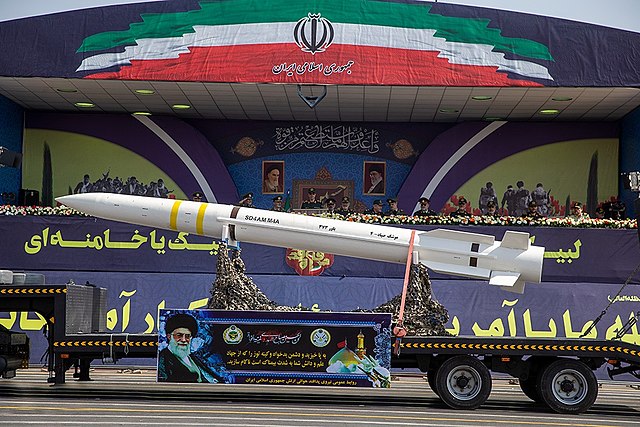Sayyad (missile)
Iranian surface-to-air missile family From Wikipedia, the free encyclopedia
Sayyad (Persian: صیاد, Hunter) is a series of solid fuel surface-to-air missiles (SAM) manufactured by Iran.
| Sayyad (Hunter) | |
|---|---|
 A Sayyad-2 system of the Islamic Republic of Iran Air Defense Force in 2015. | |
| Type | Mobile long range surface-to-air missile with anti-ballistic missile capability |
| Place of origin | Iran |
| Service history | |
| In service | 2015–present |
| Used by | Iran |
| Production history | |
| Designed | 2011 or earlier[1] |
| Specifications | |
| Warhead | Frag-HE |
| Propellant | Solid fuel |
Operational range | Sayyad-2: 40–45 km Sayyad-2C: up to 75 km Sayyad-3: 120-150 km Sayyad-4: 210 km Sayyad-4B: 400 km |
| Flight altitude | Sayyad-2: up to 27 km Sayyad-2C: up to 30 km Sayyad-3: 27-30 km Sayyad-4: 30-40 km |
| Maximum speed | Sayyad-2: Mach 3.6-4 Sayyad-2C: Mach 4.5+ Sayyad-3: Mach 4.5-5.1 |
Sayyad-1
Sayyad-1 is the Iranian upgraded version of the Chinese HQ-2 SAM; however, it differs from the Chinese versions in guidance and control subsystems. Sayyad-1 is equipped with an about 200-kilogram warhead and has a speed of about 1,200 meters per second.[2][3] The said missile is very different from the rest of Sayyad family of missiles (Sayyad-2 and the successor missiles are based on US designed RIM-66 Standard missiles).
Sayyad-2
Summarize
Perspective
The Sayyad-2 is a canister-launched, reverse engineered version of the RIM-66 Standard Missile (SM-1) naval surface-to-air missile that Iran obtained from the United States before the 1979 revolution.[4] It is an upgraded version of the Sayyad-1 system with higher precision, range and defensive power. The range of the Sayyad-2 missile is not known. Different sources claim various numbers, from 60 km to 120 km.[citation needed]
After the unveiling ceremony in November 2013, it became clear that the Sayyad-2 missile looked similar to the SM-2 Standard SAM missile but its control fins were similar to the Iranian medium-range TAER-2 SAM missile.[5] It was also announced that it will have cooperation with the S-200 system via TALASH-2 interface system. It was planned that the Sayyad-2 missile will be added to Iranian Moudge-class frigates.[6] Iranian defense minister announced that Sayyad-2 covered the medium range and high altitudes and had a combined guidance system.[7]
The launcher of Sayyad-2 missile which consists of 4 canisters in a 2*2 configuration is one of the interesting things about this new Iranian surface to air missile because it has so much apparent similarity to American MIM-104 Patriot SAM system launchers.[8]
On 17 May 2024, Sayyad-2 missiles were allegedly spotted with Hezbollah after an airstrike.[9]
Variant
Mehrab is a naval version of the Sayyad-2.
Sayyad-3
Sayyad-3 is a similar missile, but with a long-range capability. It has a similar diameter as Sayyad-2 but a longer body with different wings and control surfaces. Based on current estimates Sayyad-3 has a range of about 150–200 km.[10] Iranian Defence Minister Hossein Dehghan stated the maximum range is about 120 km.[11] This missile will be added to SAM systems via the TALASH-3 system.[12] Sayyad-3 on Khordad 15 (air defense system) is capable of detecting, intercepting, and destroying six targets simultaneously. The system is capable of detecting fighter aircraft, cruise missiles and unmanned combat aerial vehicles (UCAV) from 150 kilometres (93 miles) away and is able to track them within a range of 120 kilometres (75 miles) and the Sayyad-3 missile, used by the SAM system, has a range of 200 kilometres (120 miles). The system can also detect stealth targets from a distance of 85 kilometres (53 miles) and can intercept and destroy them within a range of 45 kilometres (28 miles)[13]
It appears that two new above missiles will be used in a similar manner to the Iranian long-range SAM system Bavar-373, to cover various ranges and altitudes.[10] The missile can also be fired by the Talaash Air Defense System.[14]
Sayyad-4

Sayyad-4 (missile) is the upgraded version of Sayyad-3 with more range and better maneuverability.
Sayyad-4B
Sayyad-4B was revealed on 5 November 2022. It has a range of 400 kilometers. It is used by the Bavar-373 SAM system.[15]
See also
References
Wikiwand - on
Seamless Wikipedia browsing. On steroids.
